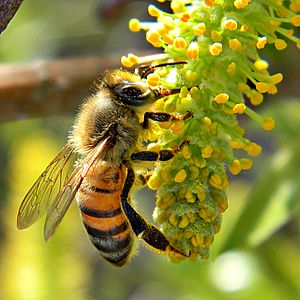Altruism facts for kids

Altruism means caring about other people and acting to help them. It's like being completely selfless. When someone is truly altruistic, they do something good for another person without expecting anything in return. This often means giving up something, like time, effort, or even possessions. They don't even expect a "thank you" or to be recognized for their good deed.
Many cultures and religions see altruism as a very good quality. It's the opposite of being selfish.
Altruism is different from helping someone because you feel responsible for them, or because you're loyal to them, like a friend or family member. People have debated for a long time if "pure" altruism is truly possible. Some people think that when you help someone, you always get a good feeling inside, like satisfaction. They wonder if this good feeling counts as a "reward."
The idea of altruism has been studied in philosophy and ethics for a long time. The word "altruism" was first used in the 1800s by a French thinker named Auguste Comte. Today, it's an important topic for psychologists, biologists, and people who study animal behavior. They all agree that altruism is about caring for others and acting to help them.
Altruism in Animals

In the animal world, we see altruism when an animal sacrifices itself for the group's survival. Scientists have different ideas about how this behavior developed through natural selection.
- Helping Family: Animals often help their close relatives more than others. This is because helping family members can help pass on shared genes.
- Helping the Group: Sometimes, helping your friends or group members can also benefit you in the long run. If your group is strong, you are safer too. Extreme self-sacrifice might happen if the whole group is in danger.
- Helping in Return: An animal might help another if there's a chance the other animal will help them back later. This is called "reciprocal altruism." Having a good reputation for helping can make others more likely to help you.
- Showing Off: Sometimes, acts of altruism can show others how strong or capable an individual is. For example, some research suggests that good hunters in the animal kingdom might have more success finding partners. In humans, people might donate money, even if it's not strictly needed, to show their generosity and improve their reputation.
These ideas help explain how evolution might have shaped our feelings and behaviors to encourage us to be altruistic.
Altruism in Religions

Most religions around the world encourage selflessness as a very important moral value. It's a key part of the teachings in Buddhism, Christianity, Hinduism, Islam, Jainism, Judaism, and Sikhism, among many others.
- Buddhism: This religion teaches love and kindness for all living things. Love means wishing all beings are happy, and compassion means wishing all beings are free from suffering. Buddhists believe that the results of our actions come from the law of karma. This means if you cause suffering, you will experience suffering. If you cause happiness, you will experience happiness.
- Sufism (a part of Islam): In Sufism, the idea of īthār means putting others before yourself. For Sufis, this means being completely devoted to others and forgetting about your own needs. It teaches sacrificing for the greater good. Islam sees those who practice īthār as showing the highest level of goodness.
Related pages
- Charity (practice)
- Empathy
- Inclusive fitness
- Philanthropy
- Misanthropy
- Theodicy of disprivilege
- Selfishness
Images for kids
-
Helping the homeless in New York City
-
Peace Corps trainees swearing in as volunteers in Cambodia, 4 April 2007
See also
 In Spanish: Altruismo para niños
In Spanish: Altruismo para niños





